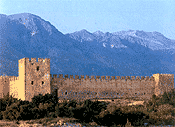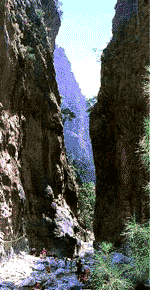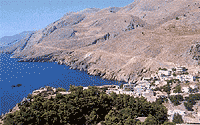 The prefecture of Chania or Hania covers the western part of Crete. It has an area of 2.376 sq. Km. And its population, according to the 1991 census, is 133.747. It is divided in five provinces: Sfakia (2.177 inh.), Kissamos (19.344), Selino (6.987), Apokoronas (11.779), and Kydonia (93.460). Basically it is a mountainous prefecture, as it contains in its boundaries the Ori (White Mountains) (2453 m.). However, there also exist wonderful beaches, mainly in the Libyan Sea which is in the southern part of the island. Hania with 60.000 inhabitants is the capital of the prefecture. It is a beautiful city, built on the sea, a very satisfactory mixture of old and new traditions both in architecture and in the way of life.
The prefecture of Chania or Hania covers the western part of Crete. It has an area of 2.376 sq. Km. And its population, according to the 1991 census, is 133.747. It is divided in five provinces: Sfakia (2.177 inh.), Kissamos (19.344), Selino (6.987), Apokoronas (11.779), and Kydonia (93.460). Basically it is a mountainous prefecture, as it contains in its boundaries the Ori (White Mountains) (2453 m.). However, there also exist wonderful beaches, mainly in the Libyan Sea which is in the southern part of the island. Hania with 60.000 inhabitants is the capital of the prefecture. It is a beautiful city, built on the sea, a very satisfactory mixture of old and new traditions both in architecture and in the way of life.
Samaria gorge
 The gorge has been declared a National Park in order to protect its rare flora and fauna, and in particular the Cretan mountain goat, called ‘’Kri-Kri’’ or the ‘’wild one’’ by the locals. Samaria was recently awarded a prize by the Council of Europe, as one of the most beautiful virgin sites in Europe. The descent into the gorge is quite difficult and crossing it takes about 6-8 hours. Hikers must wear sturdy walking shoes and hats, and carry along with them only the essentials. These do not include water, as there are springs along the way. One is allowed through the gorge from the beginning of May to the end of October. During the rest of the year, the melting snows on the high walls of the gorge and the rains raise the level of the innocent stream and turn it into a dangerous torrent. The best time of the year for the hike is May or the end of September- beginning of October, when it is not too hot, although it is relatively cool inside the gorge, since the sun only reaches down into it at noon, when its rays fall perpendicularly between the sheer walls.
The gorge has been declared a National Park in order to protect its rare flora and fauna, and in particular the Cretan mountain goat, called ‘’Kri-Kri’’ or the ‘’wild one’’ by the locals. Samaria was recently awarded a prize by the Council of Europe, as one of the most beautiful virgin sites in Europe. The descent into the gorge is quite difficult and crossing it takes about 6-8 hours. Hikers must wear sturdy walking shoes and hats, and carry along with them only the essentials. These do not include water, as there are springs along the way. One is allowed through the gorge from the beginning of May to the end of October. During the rest of the year, the melting snows on the high walls of the gorge and the rains raise the level of the innocent stream and turn it into a dangerous torrent. The best time of the year for the hike is May or the end of September- beginning of October, when it is not too hot, although it is relatively cool inside the gorge, since the sun only reaches down into it at noon, when its rays fall perpendicularly between the sheer walls. 
City of Chania
Town of Kisamos
Life is passing quietly in the town and you forget the noice of the city in its good hotels, apartments and private rooms. Its hospitality and touristic facilities in Cretan atmosphere provide whatever the visitor needs.
Town of Paleohora
In 1866, Paleohora begun to be populated again and must have taken its name from the old buildings of the venetian settlement called "Vourgo" (Palea Hora = Old Town).

